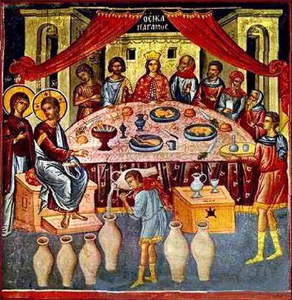
Series C
The Marriage At Cana: Gospel Analysis
John 2:1-11
The following Bible study is from a larger course entitled, THE LIFE OF CHRIST: A Study in the Four Gospels. This 54 week course for the laity will be available for congregations in 2006.
Basic text for the course: SYNOPSIS OF THE FOUR GOSPELS, Kurt Aland, English Edition, P. 23.
Remember: This gospel lesson is from the Gospel of John
- The Gospel of John is much more philosophical than the first three gospels. John prefers philosophical categories such as life, light, and logos/logic.
- The Gospel of John has long theological discourses rather than short pithy teachings and short parables.
- The Gospel of John is the Book of Sign. In John, the miracles are called “signs.” This is the Book of Signs, the miraculous events which are usually followed by a lengthy teaching discourse. The words “sign” and “signs” are used seventeen times in the Gospel of John.
The first sign that Jesus did was the turning of the water into wine. The second sign that Jesus did in the Gospel of John was the healing of the official’s son. “This was the second sign that Jesus did when he came from Judea to Galilee.” The healing miracle at the pool is the third sign in John’s gospel.
In the Gospel of John, a sign is a miracle of Jesus. This miracle is then followed by a long, philosophical discourse.
- The Gospel of John was written by an eyewitness. This gospel consistently provides little touches and details of historical anecdotes that make this gospel more alive.
- We remember that the Gospel of John is very different than the first three gospels in theology, chronology, geography. As students, we don’t try to reconcile the differences (the call of the first disciples, the placing of the cleansing of the temple, number of Jesus’ trips to Jerusalem, omission of significant stories, inclusion of significant stories, etc.)
#22 The Marriage At Cana
John 2:1-11
There is no parallel of this miracle of the “water into wine” in the first three gospels.
Message: Jesus transformed the 180 gallons of guilt (Jewish legalism, traditions and rituals) intended for purification into 180 gallons of grace. We remember John 1:16, where the Bible says, “We beheld his glory, the glorious presence of the Son of God, and from his fullness, (the fullness of six large vats of wine,) from his fullness, we all have received grace upon grace upon grace.” The Law (the first five books of the Old Testament) was given through Moses but grace and truth were given through Jesus Christ. From His fullness, we all have received grace upon grace.
In the gospel of John, the miracles are always called “signs.” The miracles are never called miracles but signs. For example, if you drive out of the parking lot of our church, you will see all kinds of signs at the nearest intersection. You will see one particular sign painted red, with white paint. The sign simply says, “Stop.” It is a stop sign. You never think that this is a piece of metal with red and white paint on it. You don’t examine the ingredients of the metal or the paint. You simply read the message. “Stop.” You ask the question, “What is the message of this sign?” So it is with the signs in the Gospel of John. You ask, “What is the message in this sign?” The signs in John’s Gospel have messages and you focus on the message more than the sign itself.
What is the message of this sign of water into wine? The message of the sign is that Jesus took 180 gallons of Jewish laws, the rituals of purification, and transformed them into 180 gallons of grace. Jesus took 180 gallons of guilt, 180 gallons of laws, laws and more laws, 180 gallons of “don’t do this and don’t do that,” 180 gallons of laws that numbered more than 600 regulations. Jesus then transformed these religious regulations into a new religion, a new wine that would burst old wine skins. Jesus transformed the old religion into the new religion. The miracle was a sign. The miracle had a message and you have to get the message. You stop at the intersection outside of church and see red and white paint painted on metal. You better get the message. “Stop.” It is the message that is important.
There is a grand message to Jesus’ first sign: 180 gallons of guilt are transformed into 180 gallons of grace.
180 gallons of grace. There is enough grace here for a whole city, enough grace for a whole state, enough grace for the whole wide world. From God’s fullness of grace, right up to the brim, we all have received grace upon grace upon grace. We love that line in the text where the vats are filled up right to the brim, right up to the top of the lip of the cup.
What does this sign mean for us today? Our relationship with Christ and our Christian faith are to be abundantly full of the grace of God. It is so easy to transform one’s religion into a thousand legalisms and ten thousand regulations. True faith is not obeying a thousand religious regulations but true faith is being filled with the fullness of God’s grace, love, Spirit and truth (from his fullness, we have received grace upon grace upon grace.)
-On the third day there was a wedding in Cana of Galilee, and the mother of Jesus was there. “The usual festivities (of a wedding) consisted of a procession in which the bridegroom friends brought the bride to the groom’s house and then a wedding supper. Seemingly, the festivities lasted seven days.” (Raymond Brown, THE GOSPEL ACCORDING TO JOHN, V. 1, p. 98. This course will primarily use Raymond Brown’s commentary on JOHN as we study the Gospel of John.)
We cannot locate the village of Cana. Perhaps it was in the hill country, nine miles north of Nazareth. (Brown, John, V. 2, p. 98).
-Jesus and his disciples had also been invited to the wedding. According to John, Jesus already had his disciples.
-When the wine gave out, the mother of Jesus said to him, "They have no wine." The reader gets the feeling that “the mother” is in charge.
-And Jesus said to her, "Woman, what concern is that to you and to me? Woman is not a term of rebuke but was Jesus’ “normal polite way of addressing women (Matthew 15:28, Luke 13:12, John 4:21)” (Brown)
-My hour has not yet come." “My hour” is a technical term in the Gospel of John and is used nine times in this gospel to refer to the hour of his crucifixion and death on the cross. (John 2:4; 8:20; 12:23, 27; 13:1; 16:2, 25, 32; 17:1.)
-His mother said to the servants, "Do whatever he tells you." The reader feels as if “the mother” of Jesus is in charge.
-Now standing there were six stone water jars for the Jewish rites of purification, each holding twenty or thirty gallons. These were large jars that held twenty to thirty gallons. Today, we recall that the average size of a garbage is thirty gallons. This was a large container.
-Jesus said to them, "Fill the jars with water." And they filled them up to the brim. We love the detail. The jars are filled right up to the brim. We recall the Biblical theme, “Fill to the brim our cup of blessing.” Jesus had these large vats filled right up to the brim.
-He said to them, "Now draw some out, and take it to the chief steward." So they took it.
-When the steward tasted the water that had become wine, and did not know where it came from (though the servants who had drawn the water knew), the steward called the bridegroom and said to him,
-"Everyone serves the good wine first, and then the inferior wine after the guests have become drunk. But you have kept the good wine until now." In this particular gospel story, Jesus brings the good wine. The new wine of Jesus’ grace, truth and love replace the inferior wine of the Old Testament rules, regulations and rituals. The old wine is the Law; the new and good wine is the Gospel.
The good wine in this story is similar to the “living water” in the story about the woman at the well, which we will study shortly.
In the first three gospels (Mark 2:9 and parallels, page 43 in our textbook), we find Jesus using “the symbolism of new wine in old wineskins in order to compare his new teaching with the customs of the Pharisees. Note that this incident occurs at the beginning of the Synoptic account of the ministry just as Cana is at the beginning of the Johannine account.” (Brown, JOHN, V. 1, p. 105)
-Jesus did this, the first of his signs, in Cana of Galilee, and revealed his glory; and his disciples believed in him. The Gospel of John is known as the Book of Signs. These signs all reveal the glory of Jesus, the shining light of God living in him. At each of these signs, someone comes to believe in him. In this event in the Gospel of John, the disciples believed.


 Back to Top Back to Top
|


